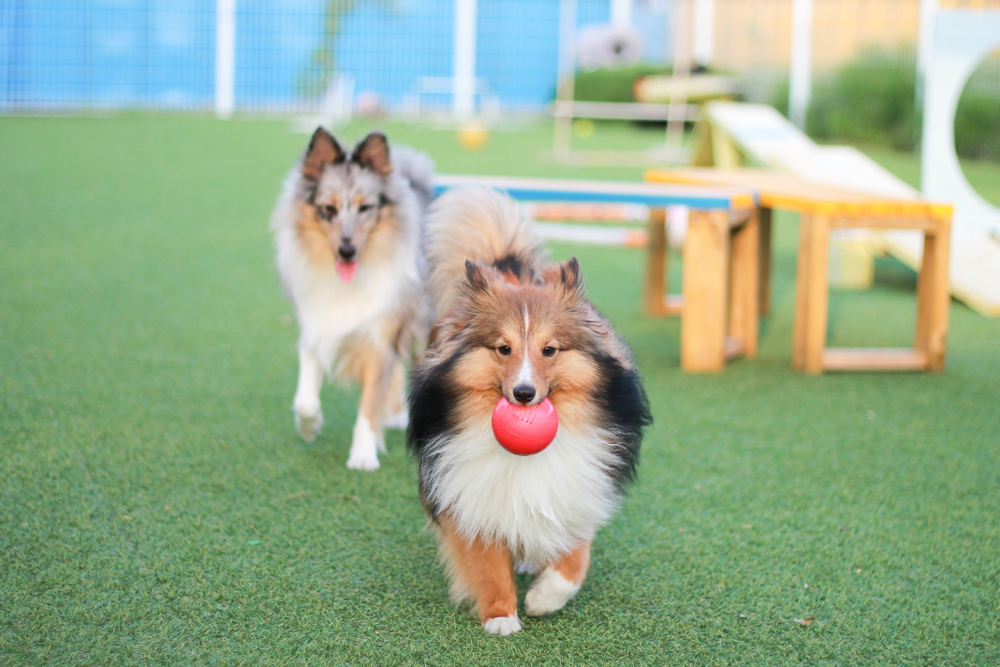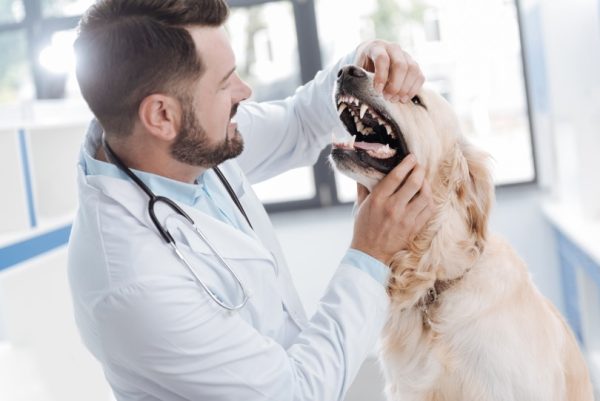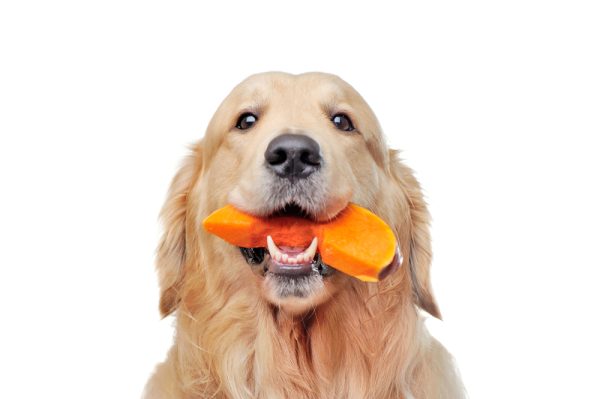Our dogs are always making us laugh with their hilarious antics. It’s hard to tell what they’ll do next. We see our dogs exhibit similar behaviors to their other canine friends, so certain behaviors are just expected of them. When it comes to bowing, dogs can do it for different reasons. Mostly, it depends on the overall body language and the context of the situation and environment they’re in. Here are some common reasons why your dog may be bowing to you.

The 5 Reasons for Dog Bowing
1. The Play Bow
Everyone who knows anything about dogs is quite familiar with the play bow. It is literally a canine’s signature invitation to a good time. You might get lots of tail wagging, pausing, intense barking, growling, and bouncing around like a total buffoon. The play bow says that your dog is ready for some fun activities, and they want you to be part of it!
If you have really paid attention, the play bow is much different from other body language. It’s a great way to distinguish whether your dog is being serious. If a dog approached a person growling with their ears drawn back, it might paint a very different picture.
The play bow simply lets the other party know that you’re not prey, you’re just for play! It lets you know that they aren’t being serious and want you to join in on the fun. This entire communication signal speaks much differently than other types of communication in dogs.
But pet dogs are not the only animals that play bow! Canines in the wild exhibit this behavior amongst each other as well. Some pretty good examples of this would include foxes, wolves, African wild dogs, coyotes, and jackals.

2. Submissiveness
If a dog is ducking their head, sinking their chest and arms lower than their backside, it can be a sign of timidness or submissiveness. Often, these behaviors are accompanied by creeping slowly toward a person, slowly and nervously licking the lips.
Often, ears are drawn back, and the tail is wagging low. Sometimes, certain dogs’ submissive peeing is accompanied by this behavior. This can be a really big problem, particularly among young females. While some dogs can grow out of it over time, it can be a real issue with others.
A Note About Submissiveness
You have to be very careful with submissiveness in dogs. Sometimes, it can be a fear-based reaction based on previous trauma or current situations. Dogs can be very sensitive to the tone of our voices and the chaos that happens around our households.
If they are feeling particularly vulnerable or anxious, they might start developing submissive behaviors if they think someone in the household is a threat. This often comes from a place of lack of safety or security. It might even also come from previous abuse or neglect. So, while it might warm your heart how sweet your dog is when they meekly approach you, it’s definitely not something that should be encouraged.
Fostering a healthy relationship with your dog can alleviate a lot of submissiveness, but some dogs are naturally inclined to take this role. So, if you’ve had a dog from a puppy, you know they haven’t been abused at all, and yet they are still submissive, it could just be a personality trait.
3. Friendliness
Sometimes, dogs will perform a play bow just because they’re being friendly. They don’t necessarily expect this newcomer to want to get down on the ground and roll around.
They might just be displaying acts of eagerness, excitement, and acceptance with a person. You will not be able to hide the immense excitement that will be coming off of them. That should be a very cheerful greeting.

4. Greeting Stretch
Something your dog might do that you might never have questioned before is a big old greeting stretch. What is that, you ask? It is when your dog knows you are there, approaches you directly, and bows down and stretches out for a big stretch, usually after waking up from a nap.
Often, it is accompanied by a large, sleepy yawn. Dogs stretch for the same reason that we do; we have to loosen those ligaments somehow. After being in the same position napping in their favorite spot, their bodies are going to be a little stiff.
Anytime you have a stiff body, you can’t deny the effects of a good stretch—neither can your dog!
5. Mimicking Exercise
The “downward dog” yoga pose wasn’t named as such by sheer coincidence. Dogs are very much capable of performing this move. It’s not unheard of for a dog to join their owners in their stretching routine and copy their movements, including the downward dog.

Why Are Some Dogs More Playful than Others?
Some dogs are naturally more inclined to be playful than others. Your dog is really looking for a little excitement in their life, and a play bow might be a daily invitation for you.
If you find that your dog is requesting playtime more than you’re able to give it, consider looking for alternative ways to exercise them appropriately. If a dog has pent-up energy, it can lead to destructive behaviors and anxious tendencies. Since behavioral changes can be challenging to deal with, it’s best to never let these problems crop up in the first place.
If you have a German Shepherd, you’re probably well aware that they need an extensive amount of exercise to stay happy. However, if you have an older, lackadaisical Pug, they might be fine with a few shakes of a toy and they’re off to take another nap. It just depends on the particular dog in question.
It is important to understand that dogs that were bred for hunting or work (such as pulling sleds or herding livestock) are naturally more inclined to be physically active. Make sure you are familiar with the characteristics and temperament of each breed, so you know what to expect when you own one. We highly encourage you to do some digging and research any breed that you want to bring into your home before you do. Often, we can fall in love with the physical appearance of a dog, but ownership can be quite a challenge if you’re not careful.


The 5 Tips for the Dog That Won’t Take No for an Answer
If your dog is extremely hyper and seems to be play bowing a lot, and it doesn’t seem like they want to listen when you decline their invitation to play, it’s time to get creative! Here are some tips and tricks on how to make sure your dog is getting enough exercise while not putting more strain on your own schedule.
1. Buy Interactive Toys
You might underestimate how well your dog can occupy themselves if given the right tools. Dogs absolutely love interactive toys and can enjoy them just fine without you around. This can help them exercise some of their predatory instincts and exert some of that energy.
- Puzzle games
- Treat dispensing balls
- Electronic toys
If you really want to get fancy and you find value in it, you could also buy your dog their very own automatic ball thrower. Granted, you would have some setting up to do outside first, but it can keep them busy for hours.
2. Get Them a Playmate
The decision to adopt another pet shouldn’t be taken lightly. In addition, please do factor in your dog’s personality; not all dogs get along with other dogs.
Have you recently considered adopting another dog? If it’s an idea you’ve had floating around your head, you might want to give it some more thought. Having another dog around is going to be twice the responsibility for you, so we definitely want to keep that in perspective.
However, if you have the time and energy to spend with the dog, having two around can actually take some of that responsibility off of you. Your dog will not rely solely on you to entertain them, as they’ll have a buddy to match their activity levels.
Naturally, this isn’t always the solution. If you are already plenty full enough with your own dog, there’s really no reason to get another. However, it can be a good option for the right circumstances.

3. Build an Obstacle Course
Your playful little buddy would probably love having their very own obstacle course. You wouldn’t have to spend a lot of money and you could probably use many items you already have around your house. If you don’t want to make one, many dog parks have agility equipment or obstacle courses to challenge their pup.
4. Find a Dog Park
Speaking of dog parks, you might want to locate one in your area! Many metropolitan areas have dog parks. Some are free to access, but others may require special documentation or memberships.
Ultimately, the dog park you pick should be based on the experiences that your dog has at them, affordability, and good company. The last thing you want to do is go to a dog park where there is a particularly bossy dog that no one seems to correct. Dog parks may also be dangerous because they are, at times, unregulated.
Dog parks depend on owners to supervise their animals. If any owner fails to do so, conflict can break out in the park. If you have a small dog, it might be better to look for a park that has a separate section for smaller dogs.


Conclusion
We hope that this article has helped you understand a little bit more about why your dog bows to you. It’s not so much a sign of respect like it is in some cultures, but rather an invitation to play or even submissiveness.
It is interesting to see how much our canine’s body language is different from ours, and how much it’s similar.
Featured Image Credit: Anna Pozzi – Zoophotos, Shutterstock



















